"The ideal build for a golfer would be strong hands, big forearms, thin neck, big thighs and a flat chest. He’d look like Popeye.”
The legendary Gary Player, the man who defined golf fitness is still at it at age 87. He works out 5 to 6 times a day, can still press over 300 pounds with his legs, and does hundreds of push-ups and situps a day. It’s no wonder why he’s still one of the fittest golfers in the game.
Then there's Tiger Woods. He took golf weight training to a whole new level sculpting his body into a lethal golfing machine. And if that wasn't enough how about those insane images of him training with Navy Seals?
In today's world of golf, the likes of Brooks Koepka and Bryson DeChambeau echo the same sentiment - a golfer's strength is a powerful weapon. With this article as your guide, we'll navigate you through the benefits of strength training for golf, show you specific golf exercises designed to increase power and distance, and help you build the perfect golf workout program.
Ever wondered why modern golfers are looking more like athletes? The reason is simple: golf is no longer just a game of technique and an afternoon stroll. It's become a test of speed, power, and endurance. And if you want to keep up and improve your game you need to focus on golf-specific strength training. It's that simple.
The insights here are shared by not only the legends of the game and the modern PGA Tour player but seasoned strength and conditioning coaches who are changing the habits and fitness routines of golfers today. We'll take you on a journey from golf exercises at home to intense sessions at the gym.
So if you're in the mood for a personal strength and conditioning coach at your disposal you need to keep reading. You'll discover workout routines and strength exercises designed to make you a better, stronger golfer. You'll also learn about injury prevention, stamina improvement, and the psychological edge that physical fitness offers.
So, whether you're a seasoned pro searching for that competitive edge, or a Sunday golfer seeking longer drives and a more rewarding game, this all-encompassing voyage into golf strength exercises is one adventure you don't want to miss.

Why Strength Training For Golfers Is Non-Negotiable?
When it comes to the golf swing, a common myth is that you either have natural talent and skill or you don’t. Yes, there are certainly some who are born with genetic gifts. They pick up a club and have a beautiful natural swing that would make the experienced scratch golfer jealous. But the truth is, anyone can drastically improve their golf game through dedicated strength training and conditioning. The repetitive asymmetrical and complex movement of the golf swing demands properly conditioned muscles, connective tissues, and joints to maximize force and minimize injury.
So what exactly is golf-specific strength training? It's not about getting ripped and bulked up like a bodybuilder. It's not about generic exercise programs. It's about focused training that targets the specific muscles and movements used in the golf swing.
Let’s take a look at the biomechanics of a powerful golf swing in simple language. The modern golf swing is all about restricting your hip rotation as you rotate your chest back. It's like winding up a spring or stretching a rubber band. Stretching your trunk allows you to store up energy that is released as you rotate through the ball generating clubhead speed.
So, strengthening the muscles of the core, back, hips, and shoulders creates more rotational power. Isolating and strengthening these muscles is the entire basis of golf strength training. This extends to the lower body too - the foundation of the golf swing and the source of additional power. You need strong glutes, quads, and calves for stability and explosiveness. Dedicated, golf-specific training protects your body while unlocking new levels of power and performance.
In essence, strength training is about understanding the science of the golf swing and tailoring your training to fit that science. A strong core provides a stable base, facilitating the smooth transfer of power from the ground, through your body, and into the club. The result - mammoth drives 20 yards past your partners. Are you ready to start training like a Pro and unleash your true power?
Benefits of Strength Training For Golfers
If you're serious about becoming a better golfer you need to invest in the right fitness program. No longer overlooked in golf, strength training has become a game-changer for golfers of all levels. Let's take a deep dive into the benefits of strength training for golf.
- Increased Swing Speed: Ever fantasize about launching a drive into the stratosphere and landing 20 yards passed your long-hitting playing partners? The secret to this? None other than strength training. By pumping up your core and legs, and through upper body exercises, you can add some serious speed to your swing. These muscles are the powerhouse of your golf swing, providing the rotational force needed for increasing clubhead speed. A stronger core means a faster swing and more distance.
- Improved Accuracy: Sure, we all love to hit it far but it doesn't help if you're missing fairways and greens. The key to lower scores is accuracy and greens in regulation. Accurate, solid ball striking is dependent on your muscle control, something that strength training can significantly enhance. By targeting exercises that increase muscle stability and coordination, you can gain better control of your swing leading to straighter more consistent shots and more birdie putts.
- Greater Endurance: A typical round of golf can last anywhere from three to over five hours, and it's not uncommon for fatigue to creep in, affecting your performance. That's when strength training can save your round. By building your muscular endurance, you'll be able to maintain your form, strength, and accuracy even as you tackle the final few holes. After all, finishing strong can be the difference between a mediocre round and an exceptional one.
- Joint Safety: Struggling with golfer's elbow? It could be the stress of your golf swing. Your swing exerts substantial stress on your joints, particularly your wrists, elbows, shoulders, and knees. Strengthening the muscles and tendons surrounding these joints creates a supportive "safety net", reducing the pressure exerted on these critical areas. As a result, you can swing more freely with greater force and without the nagging worry of joint injuries. What's more, strength training can enhance joint flexibility and mobility, promoting a smoother, more fluid swing.
- Bone Strengthening: Did you know that strength training could be an insurance policy for your bones? Regular resistance training stimulates the growth and fortification of bone tissue. This can lead to healthier and denser bones. Strength training is like a protective shield, keeping your skeletal system robust, and helping it withstand the repetitive, forceful nature of your golf swing.
- Enhanced Balance and Stability: Balance and stability form the foundation of an effective golf swing and consistent ball striking. Through dynamic and functional strength training exercises, you can improve your posture and setup, promote better weight transfer, and optimize your swing mechanics. Improved balance also reduces the risk of falls and other injuries, particularly on hilly undulating courses and in poor weather conditions.
- Injury Prevention: The golf swing is a complex, full body experience that can be stressful and result in various injuries, especially as we age. Regular strength training not only builds stronger muscles but also enhances the flexibility and resilience of tendons and ligaments. This combination of strength and flexibility can help protect your body from common golf-related injuries such as lower back pain, golfer's elbow, wrist injuries, rotator cuff tears and knee pain.
- Reduce Assymitries Tendencies: The golf swing essentially uses one side of the body. Strength training can help correct asymmetries between the left and right sides of the body that can contribute to errant shots and put you at greater risk to injury. Building balanced strength eliminates muscular imbalances that disrupt swing mechanics.
The Best Strength Training Exercises For Golfers
Hey there fitness freaks. This is the section you've been waiting for. It's time to step up your game with exercises that pack a punch. These routines target the exact muscles you use most. From power training moves using weights and machines to at-home exercises with minimal gear, we've got it all. Your new workout routine will build leg, core, and upper body strength, power-boost your drives, increase mobility, and protect you against injuries. So let's dive in, boost your fitness, and watch your golf game reach new heights.
Golf Weight Training: Unleashing the Explosive Swing
Before we begin, let's hear from the legendary Gary Player again and see if weightlifting for golfers makes sense. In a 2011 article, the Wall Street Journal quoted Mr. Player. Here's what he had to say.
"People said weight training was detrimental to golfers," recalls Mr. Player. "I was squatting 325 pounds the night before I won my first U.S. Open in 1965. Today, the players have traveling gyms."
- Bar Bell Squat: Muscles worked - Quads, glutes, hamstrings, adductor magnus, erector spinae, abs, obliques, calves. Fundamental for building lower body strength and hitting longer drives.
- Stand with feet hip-width apart, holding a dumbbell in each hand.
- Engage your core, keep your chest up, and maintain a neutral spine.
- Lower your body, bending your knees and pushing your hips back.
- Keep lowering until thighs are parallel to the floor.
- Push up through your heels and engage your glutes and quads to return to the standing position.
- Do 2 to 4 sets of 8 to 10 reps.
Variations: You can also use a barbell instead of dumbbells. With a barbell, you can do a split squat with a lunge stance. You can also use a medicine ball and do rotations. Finally, there's the unbalanced squat where you use one dumbbell rather than two.
- Single-Leg Romanian Deadlift: Muscles worked - Glutes, Hamstrings, Lower Back, Core. This is a full-body workout strengthening the lower back and core.
- Stand tall holding a dumbbell in one hand. Lift one leg a few inches off the floor.
- Keeping a flat back, hinge at the hips and lower your torso while extending the lifted leg back.
- Keep your core engaged and don't round your back.
- Once you feel a stretch in your hamstring or your torso is parallel to the floor, drive through your heel to stand back up straight. Use your glutes and hamstrings to lift back up.
- Squeeze your glutes as you return to starting position.
- Do 2 to 4 sets and 8 to 10 reps on the same side, then switch sides.
- Take it slowly keeping proper form and posture throughout.
Variations: There's a similar exercise that's a little easier - single-leg deadlift.
- Lunge with Rotation: Muscles worked: Quads, glutes, hamstrings, core, shoulders. This exercise improves rotational power, mobility, and core stability for a powerful, controlled golf swing.
- Stand tall with feet hip-width apart.
- Hold a dumbbell with both hands at chest height.
- Step forward with your right foot into a lunge position.
- Bend both knees to 90 degrees, keeping your chest up.
- Rotate your torso and the weight to the right.
- Rotate back to the center, and push off your right foot to stand back up.
- Repeat on the left side. That's one rep.
- Continue to alternate sides for 8 to 10 reps, 2 to 4 sets.
Variations: Hold a dumbbell in each hand or use a medicine ball.
- Stork Press: Muscles worked: Glutes, deltoids, triceps, core, hip abductors. The Stork Lift can help improve balance and posture increasing strength across the body perfect for adding stability and power to your swing.
- Balance on one leg, raising the knee to roughly the level of your hip.
- Activate your core muscles and ensure your glutes are working by pushing your foot firmly into the ground.
- Hold a kettlebell in the hand opposite to your standing leg, and lift it until it's at the level of your shoulder blades.
- While maintaining balance on one leg, push the weight straight up overhead and then bring it back down to shoulder level.
- Once you've completed 8 to 10 reps, switch to the other leg and arm, and repeat the process. Do 2 to 3 sets.
Variations: Use a dumbbell or even a medicine ball.
- Dumbbell Row: Muscles worked - lats, shoulders, traps, biceps, core. The Barbell Row can help improve upper body strength which is essential for a powerful and controlled golf swing.
- Stand to the left of a bench, holding a dumbbell in your right hand.
- Place your left knee and left hand on the bench for support.
- Your right foot should be planted on the floor, and your back should be parallel to the floor. Keep your back straight and core engaged.
- Let the dumbbell hang at arm's length.
- Pull the dumbbell up to your chest, keeping your elbow close to your body.
- Lower the dumbbell back to the starting position.
- Do 8 to 10 reps, then switch sides.
- Pull the barbell towards your chest, keeping your elbows close to your body.
- Lower the barbell back down to the starting position in a controlled manner.
- Do 2 to 4 sets on each side.
- Cable Wood Chop: Muscles worked - Obliques, abs, shoulders, back, hips. The Cable Wood Chop builds power and rotational strength while working the hips and core. What more could you ask for when you're looking for more distance?
- Set the cable machine with the handle at the highest position.
- Stand sideways to the cable machine, feet shoulder-width apart, and grab the handle with both hands.
- Pull the handle down and across your body to your opposite hip, twisting your torso as you pull.
- Keep your arms straight and engage your core throughout the movement.
- Slowly return the handle back to the starting position, controlling the resistance.
- Do 8 to 10 reps, then switch sides.
- Do 2 to 4 sets.
Variations: Use a Kettlebell or dumbbell.
- Hip Thrust Using Dumbbells: Muscles worked - Glutes, hamstrings, core. The hip thrust builds a strong base enabling a powerful transfer of force from the lower body to the upper body. The result is greater clubhead speed.
- Sit on the ground with your back against a bench, your knees bent, and your feet flat on the floor.
- Place a dumbbell on your hips, holding it in place with your hands.
- Drive through your heels to lift your hips off the ground while squeezing your glutes. Your shoulders should hinge on the bench, creating a straight line down to your knees.
- Lower your hips back down to the ground in a controlled motion.
- Repeat for your set of repetitions.
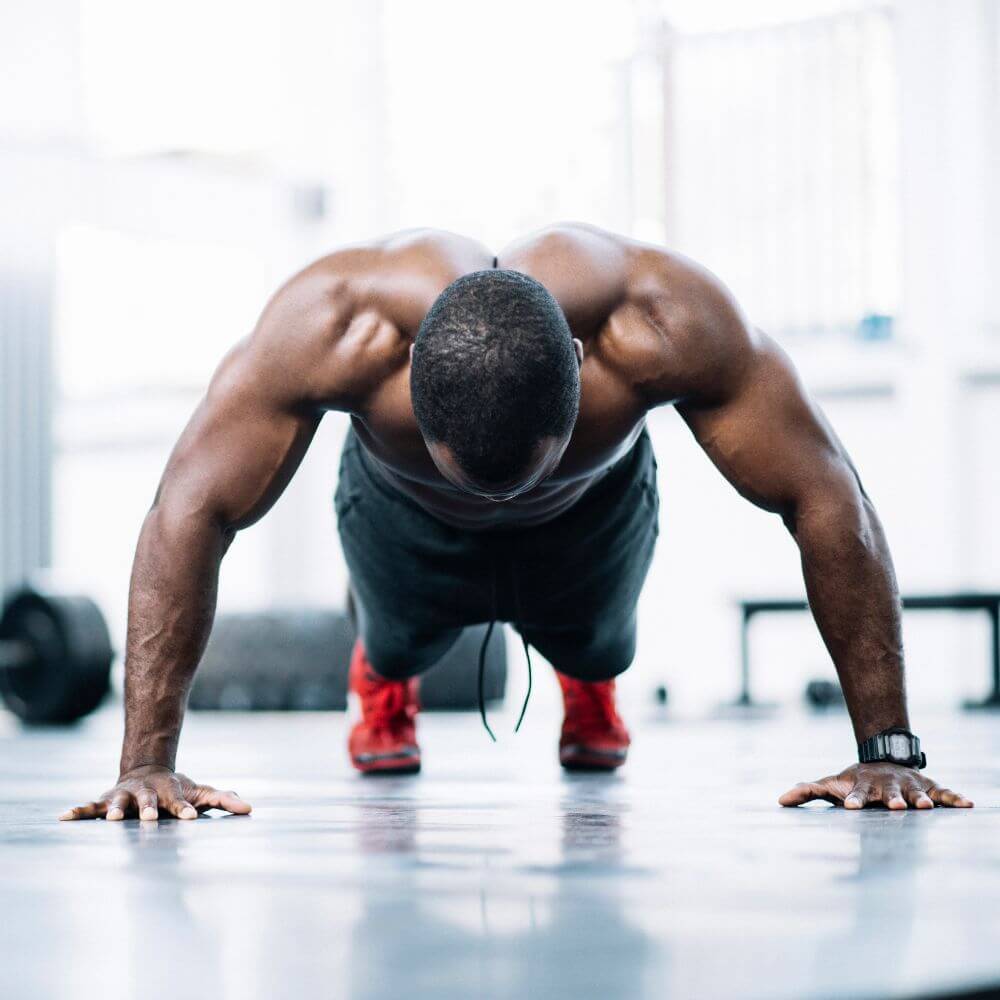
Home Tee Advantage: Golf Exercises At Home
- Push Up On A Medicine Ball: Muscles worked - Pecs, deltoids, triceps, core. This one does it all - power, balance, and stability.
- Start in a high plank position with your hands on a medicine ball under your chest.
- Ensure your body forms a straight line from your head to your heels, and your core is engaged.
- Bend your elbows and lower your chest towards the ball.
- Push your body up, extend your elbows, and return to the starting position.
- Repeat for your set of repetitions.
- Elbow Plank: Muscles Worked - Core, Shoulders, Glutes. A strong core is essential for maintaining balance during the golf swing and for generating power.
- Start by lying face down.
- Prop yourself up onto your elbows, aligning them directly beneath your shoulders.
- Push up onto your toes and lift your body off the ground, maintaining a straight line from your head to your feet.
- Keep your core engaged, your back flat, and your body straight.
- Hold this position for the desired amount of time.
- Dead Bugs: Muscles worked - Core, hip. Helps strengthen the core promoting balance and stability in the golf swing. One of the best golf exercises if you're suffering from lower back pain.
- Start by lying on your back on the floor or a mat.
- Lift your arms and point them towards the ceiling.
- Bring your legs up so your knees are bent at 90-degree angles.
- Slowly extend your right arm behind you and your left leg in front of you, keeping your lower back pressed against the floor.
- Return your arm and leg to the starting position.
- Repeat on the other side with your left arm and right leg.
- Continue alternating sides for your set of repetitions.
- Cross Climber with Shoulder Tap: Muscles worked - Core, shoulders, glutes, core, hips. This exercise enhances coordination, improves core strength, and boosts shoulder stability. Just what you need for a balanced powerful swing.
- Start in a high plank position, hands directly under shoulders, body forming a straight line from head to heels.
- Lift your right knee and bring it across towards your left elbow.
- Return to the starting position.
- Now, tap your left shoulder with your right hand, while keeping your core engaged to maintain balance.
- Return your hand to the floor.
- Repeat the cross climber and shoulder tap on the other side, bringing your left knee towards your right elbow, then tapping your right shoulder with your left hand.
- Continue alternating sides for your set of repetitions.
Mastering the Game: Essential Elements In Golf Strength Training
Hopefully, if you're still with us you realize that designing a golf training program requires some strategic planning. You can't just wing it and expect to see results. It's not much different than trying to navigate your game around a challenging golf course.
If you want to start crushing drives, having more energy on the golf course, and shooting lower scores there are several factors you need to consider:
- Find Your Balance: Start by evaluating your current fitness level and identifying any weak spots. This forms the basis of your training plan.
- The Planes of The Golf Swing: Implement exercises that mimic the multi-dimensional movements of a golf swing.
- Create a Methodical Workout Routine: Gradually increase the intensity of your training by adding weights, increasing repetitions, or varying the exercises.
- Nutrition Is Key: Consume a balanced diet to fuel your workouts and recovery process and ensure you stay properly hydrated. Let's look at another quote from Gary Player, this time from Essentially Sports. Here he's talking about the 60/40 ratio (40% being exercise.
“I now put eating at 60 percent because as you get older, you put on weight. And weight stops a train,” said Player. “When you get heavier and try to swing with the same force, you did as a young person, which you can’t do, but you’re trying to do it. That’s a quick way to get injury,” revealed Gary.
- Warm-Up: Always begin your training sessions with a warm-up to boost your heart rate and prepare your body for exercise.
- Forget the Qiuick Fix: Aim for steady, gradual progress rather than expecting instant results, as the latter can lead to injuries.
- Take Time Off: Make sure to incorporate rest days into your routine; this is when your muscles recover and grow stronger.
Now let's outline a complete annual training plan from preseason to in-season...
The Blueprint For Strength Building In Golf
Are you ready to boost your game to new heights? Welcome to our exclusive Golf Training Program, designed explicitly for golfers like you! Imagine going through a transformation that not only adds more yards to every golf club in your bag but also enhances your precision and endurance, round after round. The secret? It's in your fitness routine.
Our program progresses through distinct phases - Preseason, Midseason, In-Season, and Recovery. Each phase focuses on a unique aspect of your strength and performance, tailored to the needs of your game at that time. Whether you're working on building muscle strength, developing explosive power, maintaining your gains, or restoring your body, we've got you covered. So, put on your workout gear, it's time to begin this game-changing journey.
- Preseason Phase: Emphasize overall muscle growth and foundational strength using compound lifts like squats and presses (3-4 sets, 6-8 reps).
- Midseason Shift: Transition to power-building using high-intensity exercises like cleans, jumps, and medicine ball throws (3-5 sets, 3-5 reps).
- In-Season Maintenance: Focus on retaining strength using 2-3 sets of 8-12 reps on core lifts. Don't forget about mobility and tissue health.
- Recovery Phase: During the off-season dedicate 1-2 weeks for active rest and restoration through lighter training, flexibility exercises, and balanced nutrition.
Setting Up Your Weight Training Program: Basic Equipment and Budget-Friendly Replacements
Jumpstarting your weight training program doesn't necessitate an upscale gym membership or super high-end equipment. All you need is a collection of basic tools to begin your journey. Here are the essentials include:
- Adjustable Bench: A bench with adjustable positions not only serves for bench presses but also provides a platform for exercises like step-ups, Bulgarian split squats, and more.
- Set of Dumbbells: Dumbbells offer a great deal of flexibility in your routine, allowing for both isolated and compound movements. They can target specific muscle groups and aid in building balanced strength.
- Squat Rack: A sturdy squat rack with adjustable safeties forms the backbone of your strength training program. This multi-purpose equipment can facilitate a variety of compound movements, from squats to overhead presses.
- Olympic Barbell and Weight Plates: An Olympic barbell paired with weight plates of varying pounds allows you to scale your workout's intensity as you progress. It is a crucial component of any serious weight training program.
- Kettlebell: A kettlebell is a cast-iron or steel weight that resembles a cannonball with a handle. They're designed for a variety of exercises that combine cardio, flexibility, and strength training. Some common exercises with kettlebells include swings, squats, presses, and snatches.
However, if you find acquiring this equipment is a challenge - too costly or maybe you don't have the space, don't fret. Here are some great cost-effective alternatives and additional solutions:
- Household Items or Water Gallons: Everyday objects like canned goods, water gallons, or heavy books can be used as substitutes for traditional weights.
- Bodyweight Exercises: Movements such as push-ups, lunges, and planks harness the power of your body weight to build strength and muscular endurance.
- Affordable Resistance Bands: Resistance bands are not only versatile but also fairly cheap compared to weights. They come in different resistance levels to provide a progressive challenge as your strength grows.
- Medicine Ball: This is a weighted ball of 2 to 25 pounds and up to 14 inches in diameter. It's a versatile tool ideal for enhancing power, speed, and core workouts, enabling a wide range of movements like throwing, slamming, rotating, or supplementing traditional exercises.
- Discounted Equipment: Keep an eye on thrift stores, online classifieds, or community sales where you may find gently used fitness equipment at a fraction of the retail price.
- Community Resources: Your local community may offer resources like community centers, parks with fitness equipment, or schools that open their gyms to the public outside school hours.
Mend and Defend: A Golfer's Playbook for Injury Prevention and Recovery
A golf swing requires rotational strength, stability, mobility, and power. The swing motion torques the spine and puts stress on multiple muscle groups. Poor physical conditioning leads not only to inconsistent swings and lower swing speeds but also increases the risk of injury. Here are common injuries found among golfers of all ages.
- Lower Back Pain


- Wrist Tendonitis
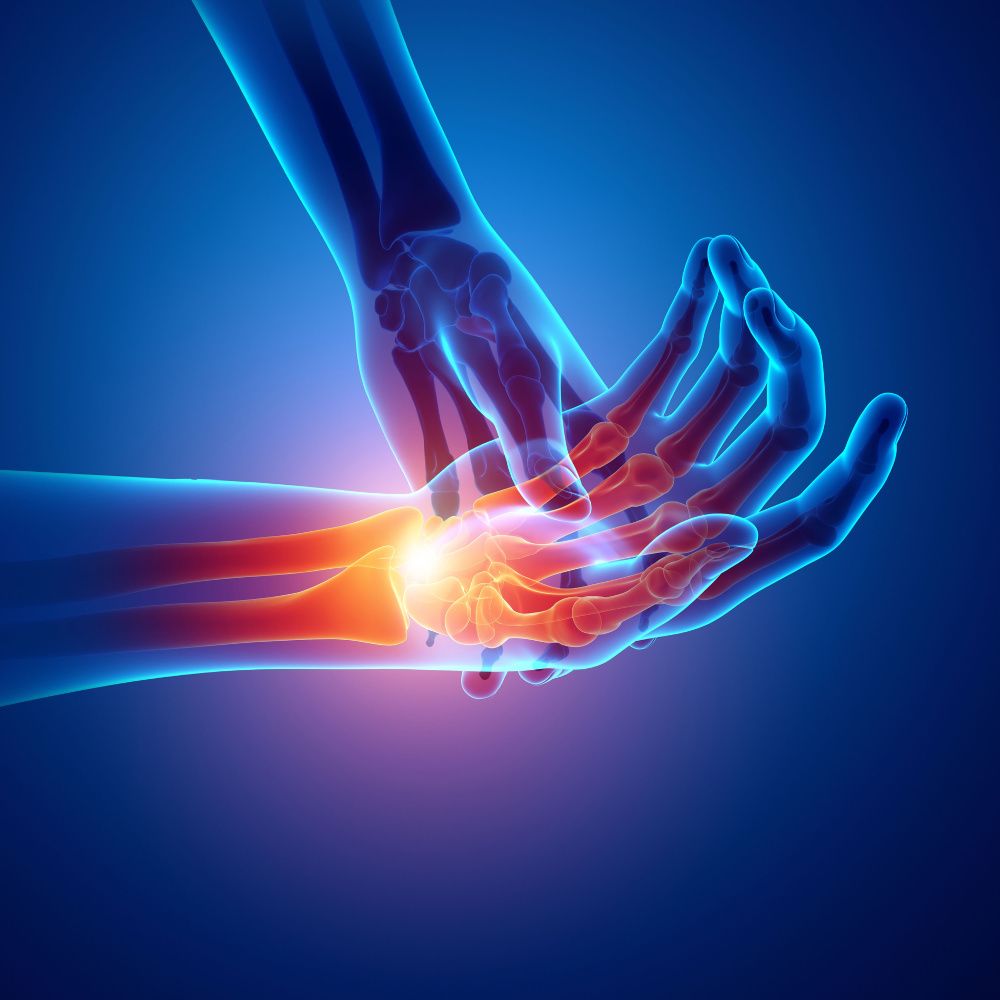
- Golf Elbow Issues

- Knee Pain
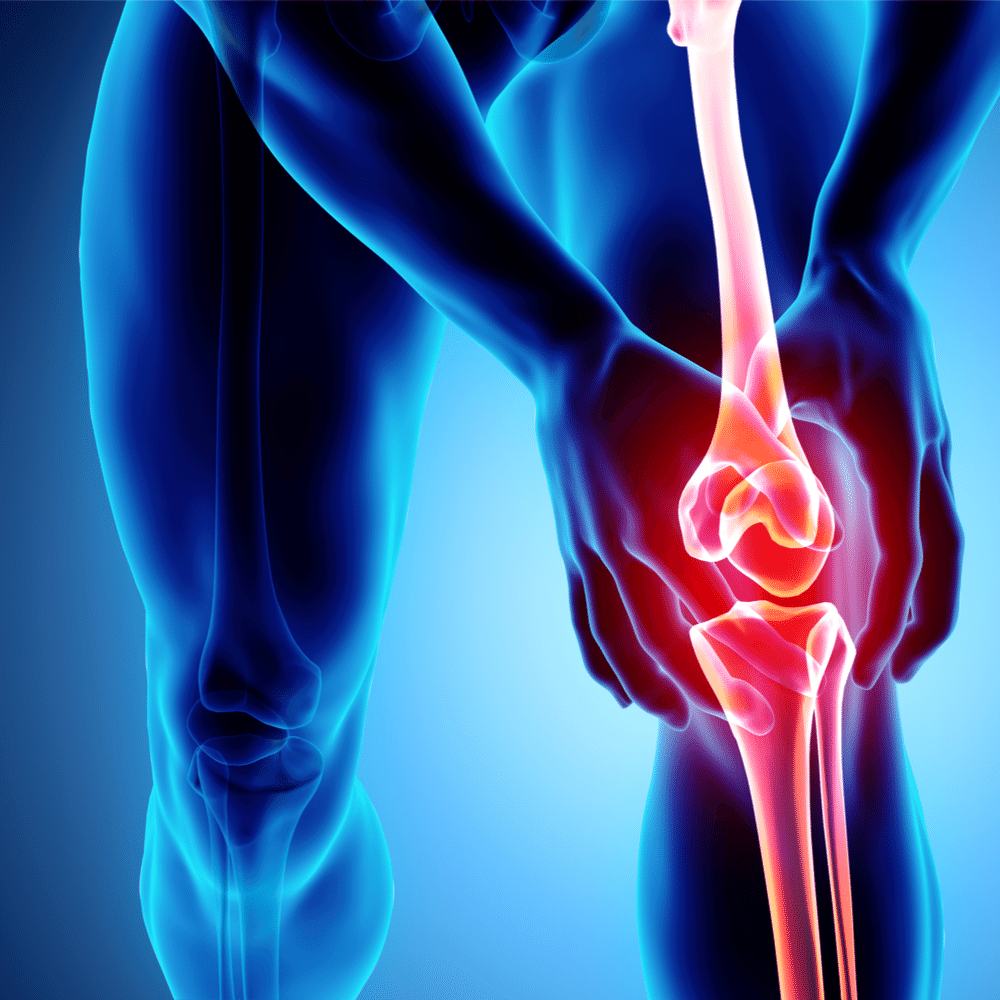
- Rotator Cuff Tears
Proper strength training actually helps prevent and rehab many golf injuries. However, make sure to consult a sports medicine professional if you're dealing with any serious issues.
Targeted strength work rebalances muscle groups. Improved flexibility alleviates joint stress. And regular conditioning enhances tissue capacity and resilience.
Implementing prehab exercises that focus on joint stability, mobility, and muscle balance is the key to your long-term golf health and more enjoyment on the links.
The Mind Game: Exploring the Cognitive Advantages of Strength Training
Let's not overlook the mental side of the game. Concentration and focus separate the pros from the weekend hacker. Developing mental focus and discipline is just as important as physical training and swing mechanics. A stronger body helps build a stronger mind.
Here are some of the cognitive benefits of strength training:
- Enhanced Physical Self-Efficacy: Observing tangible progress and mastering the techniques involved in strength training can boost one's sense of physical competence and confidence.
- Development of Self-Discipline: The consistent dedication required for regular strength training sessions cultivates a strong sense of self-discipline.
- Improved Focus: The act of lifting heavy weights necessitates razor-sharp focus, enhancing overall concentration abilities.
- Stress and Anxiety Reduction: The physical adaptations resulting from regular strength training have been linked to decreased levels of stress and anxiety.
- Fostering of Willpower and Resilience: Overcoming the inherent challenges posed by strength training can build greater willpower and resilience, vital traits that can be applied to other areas of life.
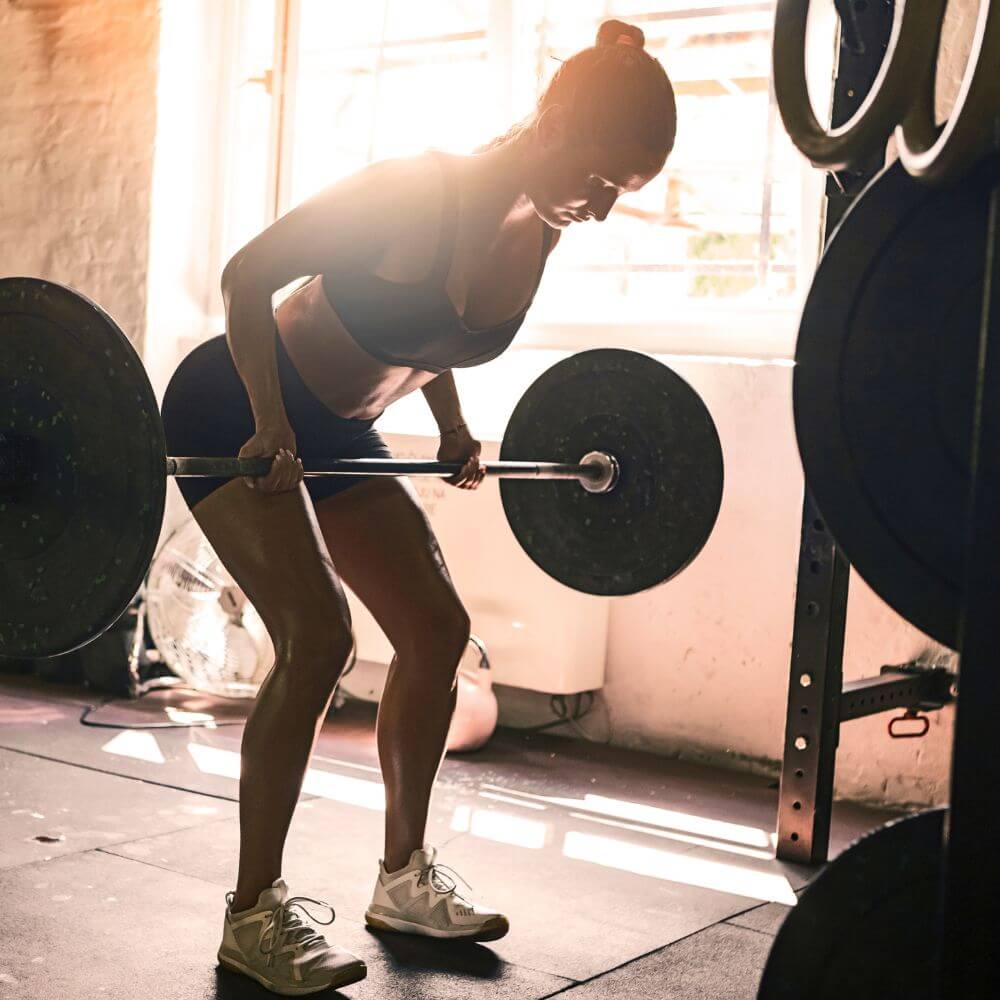
The Final Hole: Why Every Golf Swing Begins in the Gym!
So that brings to a close our comprehensive guide on golf strength training. Remember golf isn't just about the mechanics of your golf swing. It's also about the strength you build in the gym, physically and mentally, to enhance your swing. Every workout session is another layer added to becoming a better golfer.
Golf is a challenge, an engaging dialogue between your physical skills and your mental determination. But with every perfectly struck shot, your hard work pays off. Each rep brings you one step closer to sinking that birdie putt.
So the next time you think it's okay to skip weight training, think again. And remember what a great producer once said:
"The harder I work, the luckier I get."
Samuel Goldwyn
Thanks for visiting. We can't wait to see you again!
"Keep it in the short grass"
Joseph








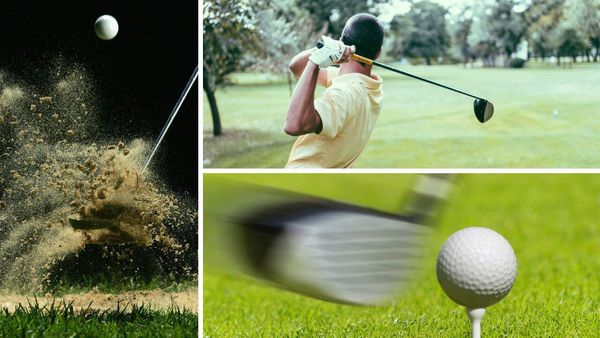
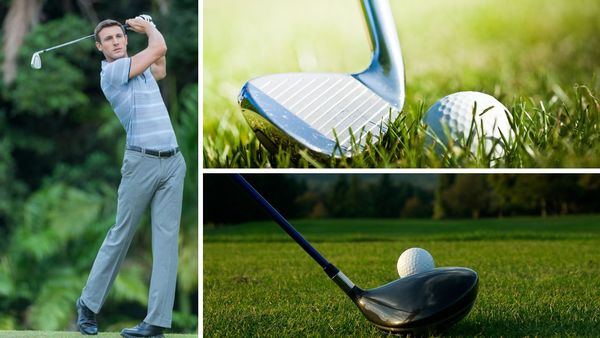

Member discussion